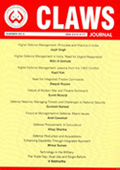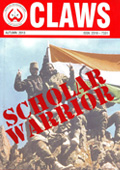|
After having overrun Mosul and Tikrit, armed militants of the al Qaeda-linked militant organisation the Islamic State in Iraq and Syria (ISIS; also called the Islamic State in Iraq and al-Sham and ISIL – Islamic State in Iraq and the Levant), are close to knocking on the gates of Baghdad. They have seized key border crossings with Syria and Jordan. Meanwhile, forces of the Kurdistan government have captured Kirkuk, regarded as the Kurd capital.
The civil war in Iraq and Syria is only the latest manifestation of conflict in West Asia that is driven by unstable states and deep-rooted divisions in society on sectarian lines. Stretching from the edge of the Indian Sub-continent in the east to the Horn of Africa in the west, West Asia has often been called the ‘Arc of Crisis’. The popular image of West Asian instability is that of a chaotic world, crumbling everywhere and always falling apart, an area governed by abrupt, sweeping changes and unpredictable developments. The West Asian states are locked in internecine quarrels due to religious, ethnic or historical rivalries and inherited colonial legacies such as boundary disputes. West Asia is a house divided, an Islamic world divided against itself despite the strongest possible motive for unity – a shared hostility towards Zionism.
The long-standing Arab and Palestinian opposition to the existence of Israel as a nation-state and senseless terrorism directed against the Jews, have led Israel to pursue a belligerent foreign and national security policy that is not conducive to peace in the region. Israel’s annexation of the whole of the West Bank and Gaza, as well as East Jerusalem and the Golan Heights in Syria in the 1980s remains unacceptable to the Arabs and the Muslim world. Israel’s excursion deep into Lebanon in 1982, all the way up to Beirut, created more problems than it solved. The Palestine Liberation Organisation (PLO), whose evacuation from Lebanon was secured by Israel at great cost, was soon back in strength. Palestinian and Hizbollah terrorism has abated somewhat after Israel’s pull-out from the occupied territories in Gaza and South Lebanon, but sporadic violence continues; and, Israel’s on-off rocket, missile and air attacks against Hamas militiamen remain in the headlines.
The continuing deadlock over Palestine remains a vexatious issue. Though the world accepts the Palestinians’ right to an autonomous state, the issue is still to be finally resolved. Prime Minister Yitzhak Rabin’s historic handshake with Chairman Yasser Arafat in September 1993 had changed the course of history but has so far led only to a temporary reprieve. The installation of a Hamas-supported Palestinian government has further exacerbated the situation.
Lebanon was more strife-riven and unstable during the last two decades of the 20th century than at any other time in its bloody and chequered history. The Israel-Lebanon conflict of July 2006, sparked by the capture of Israeli soldiers by the Hizbollah, was a new watershed in a volatile conflict zone. Without the presence of the United Nations Interim Force in Lebanon (UNIFIL) on the Israel-Lebanon border, daily incidents of terrorism and violence would have continued unabated.
The occupation of Iraq by the US-led coalition forces in 2003, ostensibly to capture and destroy Saddam Hussein’s WMDs – which were never found – further destabilised the region, shattered Iraq’s economy and drove up oil prices. The vacuum left behind in Iraq by the withdrawal of the US-led coalition forces in December 2011, led to the rise of Sunni militancy, which is supported by Saudi Arabia. The participation of a large number of Saudi nationals in the September 11 attacks in the US and Saudi support for Sunni uprisings, have gradually cooled the cosy relationship between the US and Saudi Arabia.
The Arab Spring protests in Syria, which began in March 2011, degenerated into a full-fledged civil war by July 2012. The aim of the opposing forces is to overthrow President Bashar al-Assad’s Ba’ath government that has been in power since 1963. The main motives of the broad range of opposition groups, from Islamists to leftwing secular parties and youth activists, are to end repression and undertake political reform. Iran and Russia support the Assad government.
The European Union has estimated that 2,000 European citizens have joined the Jihadist groups fighting government forces. European governments are concerned that these battle-hardened combatants would pose a long-term security threat when they return. The crisis in Syria has led to the exodus of a large number of refugees and could soon assume ominous regional dimensions. It has already spilled over into Iraq in the form of a Shia-Sunni conflict.
Instability and superpower rivalry in West Asia does not augur well for India’s security and commerce. Combined with the escalation of force levels in the Indian Ocean, the heightened tensions in West Asia may ultimately lead to a spill over of the conflicts to adjacent areas. India now imports almost 75 per cent of the oil required to fuel its growing economy and most of it comes from the Gulf. The long-drawn conflicts of the last two decades of the 20th century had forced India to buy oil at far greater cost from distant markets, with no assurance of guaranteed supplies. The 1991 oil shock had almost completely wrecked India’s foreign exchange reserves. The present situation is again becoming critical. Oil prices are ruling at about US$ 115 per barrel.
Since the early 1970s, Indian companies have been winning a large number of contracts to execute turnkey projects in West Asia. The conflict in the region has virtually sealed the prospects of any new contracts. Also, payments for the ongoing projects are not being made on schedule, leading to un-absorbable losses for the Indian firms involved, and a dwindling foreign exchange income from the region. A large number of Indian workers are employed in West Asia and many of them have had to be evacuated. As an emerging power sharing a littoral with the region, India has an important role to play in acting as a catalyst for West Asian stability through negotiations and dialogue rather than confrontation.
The author is former Director, CLAWS.
| 

